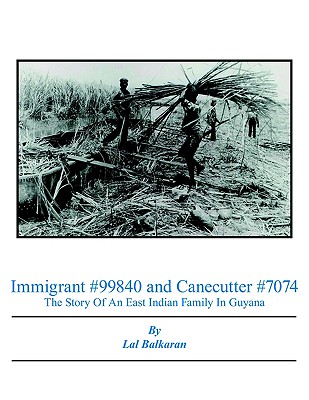Immigrant # 99840 and Canecutter # 7074: The Story of an East Indian Family in Guyana is a most valuable document that fills a major gap in the writings which deal with the East Indian presence in Guyana. In focusing on an individual family's history and its network of relationships, Lal Balkaran throws light on those more inward experiences of the Indo-Guyanese absent from more general historical and social studies and which so far only fiction has hinted at. From the arrival of his foreparents as indentured immigrants from India in 1905, through to his family's departure to Canada in the 1980s, Lal Balkaran writes a personal and individual narrative, but one which will be full of resonances for other Guyanese. Balkaran's research into this "micro-level" aspect of history helps us to even better understand in general the historical evolution of the Guyanese nation, and that of Caribbean people of Indian ancestry in particular. Indeed, the author knows his subject well, and has made a more than useful contribution to the history of Indians in the Caribbean. This almost 230-page book contains a wealth of information organized around nine chapters with the issues and events categorized into sixty sub-headings. There are 41 photographs and copies of authentic immigration documents, a 141-word glossary, a 50-book bibliography, a profile of Guyana with unique statistics, and an 800-word index. Many Guyanese will reminisce over their own experiences which are so identifiable to those detailed in this wonderful book. It also provides a social history of the decades of the '60s, '70s, and '80s, and contains invaluable lessons on growing up and dealing with struggles, challenges, failures, and aspirations. With a setting on a sugar plantation, various aspects of village life, education, religion, culture, race, and Guyana's fierce politics are analyzed to show their impact on the family unit in a multiracial society amidst the scars of colonialism and also in an independent Guyana. Poverty, human misery, exploitation, discrimination, and social as well as moral degeneracy in all their nakedness are carefully documented from actual experience. Amidst it all there is resilience. The author also talks about his five years spent in Guyana's hinterland among the Wapishanas, one of the nine Amerindian tribes now living in Guyana. A whole chapter has been devoted to these years to bring to light such issues and events like life in the savannas, hunting, farming, fishing, cultural activities, and everyday routine of the Wapishanas. Finally, emigrating and living in a first world country is examined in a broader context to cover such issues as adjusting to a new life in a multicultural environment. Understanding the forces that are constantly changing and reshaping the way immigrants think and live, shifting demographics, globalization, and the conduciveness of the new society to immigrants' successes and failures are all examined. Lal Balkaran has authored seven books on business and four on his native Guyana including Dictionary of the Guyanese Amerindians and Other South American Native Terms, Bibliography of Guyana and Guyanese Writers, and The Rupununi Savannas of Guyana: A Visual Journey. See www.lbapublications.com.
| FindBook |
有 1 項符合
Immigrant #99840 and Canecutter #7074: The Story of an East Indian Family in Guyana 1905-2005的圖書 |
 |
Immigrant #99840 and Canecutter #7074: The Story of an East Indian Family in Guyana 1905-2005 作者:Balkaran 出版社:Authorhouse 出版日期:2006-06-22 語言:英文 規格:平裝 / 196頁 / 28.2 x 21.3 x 1.3 cm / 普通級 |
| 圖書館借閱 |
| 國家圖書館 | 全國圖書書目資訊網 | 國立公共資訊圖書館 | 電子書服務平台 | MetaCat 跨館整合查詢 |
| 臺北市立圖書館 | 新北市立圖書館 | 基隆市公共圖書館 | 桃園市立圖書館 | 新竹縣公共圖書館 |
| 苗栗縣立圖書館 | 臺中市立圖書館 | 彰化縣公共圖書館 | 南投縣文化局 | 雲林縣公共圖書館 |
| 嘉義縣圖書館 | 臺南市立圖書館 | 高雄市立圖書館 | 屏東縣公共圖書館 | 宜蘭縣公共圖書館 |
| 花蓮縣文化局 | 臺東縣文化處 |
|
|
圖書介紹 - 資料來源:博客來 評分:
圖書名稱:Immigrant #99840 and Canecutter #7074: The Story of an East Indian Family in Guyana 1905-2005
|











